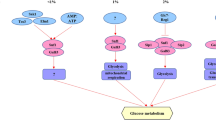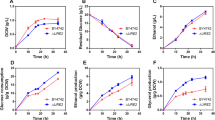Abstract
Evidence suggests that AMP protein kinase (AMPK) is the main target of the phytochemical resveratrol (RSV) in mammalian cells. Data also indicates that RSV stimulates glucose metabolism; however, the molecular link between RSV and glucose uptake remains unknown. Herein, we provide evidence indicating that RSV stimulates glycolysis via sucrose non-fermenting 1 gene (SNF1, Saccharomyces cerevisiae orthologous of AMPK). S. cerevisiae cultures treated with 30 μM RSV showed an increase in extracellular acidification rate compared to untreated cells, indicating an elevated glycolytic flux. Also, RSV treatment increased transcription levels of two key glycolytic genes, hexokinase 2 (HXK2) and phosphofructokinase 1 (PFK1), as well as production of NADH. Moreover, RSV treatment inhibited mitochondrial respiration when glucose was used as a carbon source. Importantly, the effects of RSV on glycolysis were dependent of SNF1. Taken together, these findings suggest that SNF1 (AMPK in mammalian systems) is the molecular target of RSV in S. cerevisiae.





Similar content being viewed by others
References
Aguilar-Toral R et al (2014) Characterization of the effects of a polyunsaturated fatty acid (PUFA) on mitochondrial bioenergetics of chronologically aged yeast. J Bioenerg Biomembr 46:205–220. doi:10.1007/s10863-014-9550-3
Baur JA et al (2006) Resveratrol improves health and survival of mice on a high-calorie diet. Nature 444:337–342. doi:10.1038/nature05354
Bernofsky C, Swan M (1973) An improved cycling assay for nicotinamide adenine dinucleotide. Anal Biochem 53:452–458. doi:10.1016/0003-2697(73)90094-8
Breen DM, Sanli T, Giacca A, Tsiani E (2008) Stimulation of muscle cell glucose uptake by resveratrol through sirtuins and AMPK. Biochem Biophys Res Commun 374:117–122. doi:10.1016/j.bbrc.2008.06.104
Catalgol B, Batirel S, Taga Y, Ozer NK (2012) Resveratrol: french paradox revisited. Front Pharmacol 3:141. doi:10.3389/fphar.2012.00141
Escote X et al (2012) Resveratrol induces antioxidant defence via transcription factor Yap1p. Yeast 29:251–263. doi:10.1002/yea.2903
Gallis JL, Serhan N, Gin H, Couzigou P, Beauvieux MC (2012) Resveratrol plus ethanol counteract the ethanol-induced impairment of energy metabolism: (3)(1)P NMR study of ATP and sn-glycerol-3-phosphate on isolated and perfused rat liver. Pharmacol Res: Off J Ital Pharmacol Soc 65:387–395. doi:10.1016/j.phrs.2011.12.003
Gancedo JM (1998) Yeast carbon catabolite repression. Microbiol Mol Biol Rev 62:334–361
George P (1947) Reaction between catalase and hydrogen peroxide. Nature 160:41–43
Hagman A, Sall T, Piskur J (2014) Analysis of the yeast short-term Crabtree effect and its origin. FEBS J 281:4805–4814. doi:10.1111/febs.13019
Hardie DG, Carling D, Carlson M (1998) The AMP-activated/SNF1 protein kinase subfamily: metabolic sensors of the eukaryotic cell? Annu Rev Biochem 67:821–855. doi:10.1146/annurev.biochem.67.1.821
Hawley SA et al (2010) Use of cells expressing gamma subunit variants to identify diverse mechanisms of AMPK activation. Cell Metab 11:554–565. doi:10.1016/j.cmet.2010.04.001
Hedbacker K, Carlson M (2006) Regulation of the nucleocytoplasmic distribution of Snf1-Gal83 protein kinase. Eukaryot Cell 5:1950–1956. doi:10.1128/EC.00256-06
Hedbacker K, Carlson M (2008) SNF1/AMPK pathways in yeast. Front Biosci 13:2408–2420. doi:10.2741/2854
Heyland J, Fu J, Blank LM (2009) Correlation between TCA cycle flux and glucose uptake rate during respiro-fermentative growth of Saccharomyces cerevisiae. Microbiology 155:3827–3837. doi:10.1099/mic.0.030213-0
Korshunov SS, Skulachev VP, Starkov AA (1997) High protonic potential actuates a mechanism of production of reactive oxygen species in mitochondria. FEBS Lett 416:15–18. doi:10.1016/s0014-5793(97)01159-9
Kotyk A, Lapathitis G, Krenková S (1999) Glucose- and K + −induced acidification in different yeast species. Folia Microbiol (Praha) 44:295–298. doi:10.1007/BF02818550
Lagouge M et al (2006) Resveratrol improves mitochondrial function and protects against metabolic disease by activating SIRT1 and PGC-1alpha. Cell 127:1109–1122. doi:10.1016/j.cell.2006.11.013
Liu K, Zhou R, Wang B, Mi MT (2014) Effect of resveratrol on glucose control and insulin sensitivity: a meta-analysis of 11 randomized controlled trials. Am J Clin Nutr 99:1510–1519. doi:10.3945/ajcn.113.082024
McCord JM, Fridovich I (1969) Superoxide dismutase an enzymic function for erythrocuprein (hemocuprein). J Biol Chem 244:6049–6055
Moreira AC, Silva AM, Santos MS, Sardao VA (2013) Resveratrol affects differently rat liver and brain mitochondrial bioenergetics and oxidative stress in vitro: investigation of the role of gender. Food Chem Toxicol: Int J Publ Br Ind Biol Res Assoc 53:18–26. doi:10.1016/j.fct.2012.11.031
Park SJ et al (2012) Resveratrol ameliorates aging-related metabolic phenotypes by inhibiting cAMP phosphodiesterases. Cell 148:421–433. doi:10.1016/j.cell.2012.01.017
Rosenfeld E, Beauvoit B (2003) Role of the non-respiratory pathways in the utilization of molecular oxygen by Saccharomyces cerevisiae. Yeast 20:1115–1144. doi:10.1002/yea.1026
Sassi N, Mattarei A, Azzolini M, Szabo I, Paradisi C, Zoratti M, Biasutto L (2014) Cytotoxicity of mitochondria-targeted resveratrol derivatives: interactions with respiratory chain complexes and ATP synthase. Biochim Biophys Acta 1837:1781–1789. doi:10.1016/j.bbabio.2014.06.010
Su H, Hung L, Chen J (2006) Resveratrol, a red wine antioxidant, possesses an insulin-like effect in streptoztocin-induced diabetic rats. Am J Endocrinol Metab 290:E1339–E1346. doi:10.1152/ajpendo.00487.2005
Teste MA, Duquenne M, Francois JM, Parrou JL (2009) Validation of reference genes for quantitative expression analysis by real-time RT-PCR in Saccharomyces cerevisiae. BMC Mol Biol 10:99. doi:10.1186/1471-2199-10-99
Timmers S, Auwerx J, Schrauwen P (2012) The journey of resveratrol from yeast to human. Aging (Albany NY) 4:146–158
Tomé-Carneiro J, Larrosa M, Gonzalez-Sarrías A, Tomas-Barberan FA, Garcia-Conesa MT, Espin JC (2013) Resveratrol and clinical trials: the crossroad from in vitro studies to human evidence. Curr Pharm Des 19:6064–6093
Um JH et al (2010) AMP-activated protein kinase-deficient mice are resistant to the metabolic effects of resveratrol. Diabetes 59:554–563. doi:10.2337/db09-0482
Ungvari Z et al (2009) Resveratrol attenuates mitochondrial oxidative stress in coronary arterial endothelial cells. Am J Physiol Heart Circ Physiol 297:H1876–H1881. doi:10.1152/ajpheart.00375.2009
Vetterli L, Brun T, Giovannoni L, Bosco D, Maechler P (2011) Resveratrol potentiates glucosestimulated insulin secretion in INS-1E beta-cells and human islets through a SIRT1-dependent mechanism. J Biol Chem 286:6049–6060. doi:10.1074/jbc.M110.176842
Ye J, Coulouris G, Zaretskaya I, Cutcutache I, Rozen S, Madden TL (2012) Primer-BLAST: a tool to design target-specific primers for polymerase chain reaction. BMC Bioinforma 13:134. doi:10.1186/1471-2105-13-134
Acknowledgments
This work was financially supported by grants from Instituto Tecnológico Superior de Ciudad Hidalgo (3308.100310) and Universidad Autónoma de Querétaro (FCQ201417). The PROMEP program contributes with a scholarship grant for LAMP. The authors thank to Ana Karen Padilla-Pérez, Cecilia Martínez-Ortiz, Mayra Alejandra Soto-Villagómez, Josué Misael Zamudio-Bolaños, Andrés Carrillo-Garmendia and Maria Irene Cornelio-Martinez for the technical support in kinetic assays.
Conflict of Interest
The authors have no conflicts of interest to declare.
Author information
Authors and Affiliations
Corresponding author
Rights and permissions
About this article
Cite this article
Madrigal-Perez, L.A., Nava, G.M., González-Hernández, J.C. et al. Resveratrol increases glycolytic flux in Saccharomyces cerevisiae via a SNF1-dependet mechanism. J Bioenerg Biomembr 47, 331–336 (2015). https://doi.org/10.1007/s10863-015-9615-y
Received:
Accepted:
Published:
Issue Date:
DOI: https://doi.org/10.1007/s10863-015-9615-y




